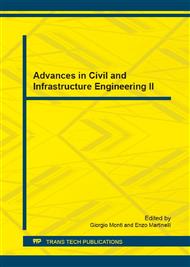[1]
S. H. Chandrahas and M. K. Gupta, An Experimental Study of Effects of Superplasticizer on Fresh and Hardened Properties of Concrete, International Journal of Engineering Research and Development, 8(1)(2013) 46-50.
Google Scholar
[2]
M. X. Chen, and Z. C. Huang, Experimental Research on Performance of Dry-Grinding Fine Cement of Grouting, Journal Wuhan University of Technology, Materials Science Edition, 17 (3)(2002)66-69.
DOI: 10.1007/bf02838544
Google Scholar
[3]
,N. C. Collier, J. H Sharp. and M. B., Milestone et al. The Influence of Water Removal Techniques on the Composition and Microstructure of Hardened Cement Paste, Cement and Concrete Research, 38(6)(2008)737-744.
DOI: 10.1016/j.cemconres.2008.02.012
Google Scholar
[4]
R. K. Dhir, M. J. McCarthy and K. A. Paine, Engineering property and structural design relationships for new and developing concretes, Materials and Structures, 38(2005)1-9.
DOI: 10.1007/bf02480568
Google Scholar
[5]
X. Feng and X. Y. Zhou, Experimental Research on Retard-bonded Prestressed Steel Strands, Journal of Highway, 10(2011) 67-70.
Google Scholar
[6]
M. Geromel and O. Mazzarella, Experimental and analytical assessment of the behavior of stainless steel reinforced concrete beams, Materials and Structures, 38(2005)211-218.
DOI: 10.1007/bf02479346
Google Scholar
[7]
L. F. Kahn and M. Lopez, Prestress Losses in High Performance Lightweight Concrete Pretensioned Bridge Girders, PCI JOURNAL, (2005)84-94.
DOI: 10.15554/pcij.09012005.84.94
Google Scholar
[8]
M. S. Nam and Y. K, Choi Structural Resistance Factors for Shear Loading in Drilled Shafts with Minor Flaws Based on Experimental Study, KSCE Journal of Civil Engineering, 11(5)( 2007)243-252.
DOI: 10.1007/bf02824088
Google Scholar
[9]
I. Pane and W. Hansen, Investigation of Blended Cement Hydration by Isothermal Calorimetry and Thermal Analysis, Cement and Concrete Research, 35(7)(2005)1155-1164.
DOI: 10.1016/j.cemconres.2004.10.027
Google Scholar
[10]
T. Rabczuk and T. Belytschko, Application of particle methods to static fracture of reinforced concrete structures", International Journal of Fracture, 137(2006)19-49.
DOI: 10.1007/s10704-005-3075-z
Google Scholar
[11]
Y. P. Song, New Prestressed Concrete Structure, China Machine Press, Beijing, (2006).
Google Scholar
[12]
J. M. Stallings, R. W. Barnes and S. Eskildsen, Camber and Prestress Losses in Alabama HPC Bridge Girders, PCI Journal, (2003)2-16.
DOI: 10.15554/pcij.09012003.90.104
Google Scholar
[13]
B. T. Yu, Q. C. Wang and S. Liu, Experimental Study on the Plasticity of the Super-retarding Mortar, Cement Engineering, 2(2005)39-42.
Google Scholar
[14]
L.M. Zhang, D.Q. Li and W.H. Tang, Impact of routine quality assurance on reliability of bored piles, Journal of Geotechnical and Geoenvironmental Engineering-ASCE, 132(5, )(2006)622-630.
DOI: 10.1061/(asce)1090-0241(2006)132:5(622)
Google Scholar
[15]
J. C. Zhao, Q. C. Wang and Y. H. Li, EXPERIMENTAL RESEARCH ON SUPER-RETARD-SETITING MORTAR AND RETARD-BONDED PRESTRESSED CONCRETE BEAMS, China Civil Engineering Journal, 36(8)(2003)57-62.
Google Scholar
[16]
X. Y. Zhou, X. Feng and G. H. Cao, EXPERIMENTAL RESEARCH ON RETARD-BONDED PRESTRESSED CONCRETE BEAMS, In Proceedings of the 4th International Symposium on Lifetime Engineering of Civil Infrastructure, (2009)214-219.
Google Scholar
[17]
X. Y. Zhou and X. Feng, Experimental Research on Crack Width of Retard-bonded Partially Prestressed Concrete Beams, Journal of Highway and Transportation Research and Development, 28(1)(2011)56-61.
DOI: 10.4028/www.scientific.net/amr.639-640.211
Google Scholar


